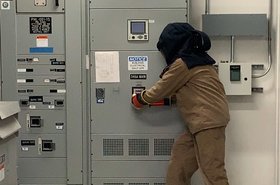The world's most powerful supercomputer lives in Japan.
The Fugaku system, developed by Fujitsu and RIKEN, has taken the top spot on the Top500 list, which ranks the most powerful systems in the world twice a year.
The supercomputer achieved a LINPACK benchmark score of 415.53 petaflops, far above US competitor Summit's 148.6 petaflops score - although that benchmark has many detractors.
But Fugaku also won on HPCG, a ranking of supercomputers running real-world applications, HPL-AI, an artificial intelligence application ranking, and Graph 500, which ranks systems based on data-intensive loads. This is the first time a system has become number one on all these benchmarks.
On the HPL-AI benchmark, designed to measure HPC performance on machine/deep learning workloads, Fugaku registered a peak performance of 1.45 exaflops, above Summit's 0.55 exaflops benchmark.
One hell of a system
Fugaku, developed over six years for $1bn, replaces Japan's K Supercomputer - which briefly held the top spot in 2011. The new supercomputer has a power load of 28.3MW, several times more than Summit's 10.1MW.
The system, which is expected to start full-time operation from April 2021, features Fujitsu A64FX processors, making it the first Arm-powered supercomputer to come in at number one on the Top500 list - and one of only four Arm systems on the current list.
The 48-core chips were developed for the supercomputer, but will be commercialized for sale later this year.
The system consists of 158,976 nodes (384 nodes per rack over 396 racks, and 192 nodes per rack across 36 racks). It has 4.85PB of total memory, and 163PB/s of memory bandwidth. It does not have any GPUs.
"The R-CCS Fugaku system is very impressive with over 7 million cores and a peak performance of 514 petaflops in 64-bit floating point for standard scientific computations and 2.15 exaflops in 16-bit floating point (not bfloat16 floating point format) for machine-learning applications," Top500 cofounder Professor Jack Dongarra said in a summary review of the supercomputer.
"The Fugaku system is almost three times (2.84x) faster than the system it replaces in the number one spot. The HPL benchmark result at 415 petaflops, or 81 percent of theoretical peak performance, is also impressive with an efficiency of 14.7 gigaflops per watt.
"The HPCG performance at only 2.5 percent of peak performance shows the strength of the memory architecture performance. The ratio of bytes per floating-point operations from memory on the ARM A64FX HBM2 memory is 0.4 bytes per double-precision flops, which shows a good balance for floating point operations to data transfer from memory. One would expect good performance on computational science problems and machine-learning applications."
The runners-up
After Fugaku and the IBM Power 9-featuring Summit comes Sierra, at the Lawrence Livermore National Laboratory.
It achieved 94.6 petaflops on HPL, also with Power 9 CPUs and Nvidia Tesla V100 GPUs.
Then comes China's most powerful system, the Sunway TaihuLight. At 93 petaflops, featuring Sunway 260-core SW26010 processors, it was the world's most powerful system when it launched in the summer of 2016.
China’s National University of Defense Technology comes in at number five with the Tianhe-2A. It boasts 61.4 petaflops with a mixture of Intel Xeons and Matrix-2000 coprocessors.
Then comes a new entrant, HPC5 - a Dell system built for Italian oil giant Eni. The fossil fuel-backed 35.5 petaflops supercomputer is the fastest machine in Europe.
Another new system comes in seventh, Selene. The 27.58 petaflops machine is built by Nvidia, for Nvidia - with Ampere A100 GPUs and Epyc CPUs.
Then comes Frontera, a 23.5 petaflops Dell C6420 system installed at the Texas Advanced Computing Center.
Italy squeezes into the top 10 again, with the Marconi-100 at the CINECA research center. With Power 9 chips and V100 GPUs, it manages 21.6 petaflops.
Rounding out the top 10 is Piz Daint at 19.6 petaflops, a Cray XC50 system installed at the Swiss National Supercomputing Centre, featuring Xeons and P100 GPUs.
The wider picture
All the systems on the Top500 together come in at 2.23 exaflops, up from 1.65 exaflops six months ago.
China still has the largest number of systems on the list at 226, aggregating at 565 petaflops of performance. The US has fewer systems, at 114 - but together they are more powerful, at 644 petaflops. As for the smaller nations, Japan has 30 systems, France 18, and Germany 16.
The most energy-efficient system on the Green500 ranking was the MN-3, based on a new server from Preferred Networks. It achieved a record 21.1 gigaflops/watt during its 1.62 petaflops performance run. It came in at number 395 in the Top500 list.
Second on the Green500 was Nvidia's Selene, built on its DGX A100 architecture. The Fugaku system came in at number nine on the Green500, just behind Summit.




